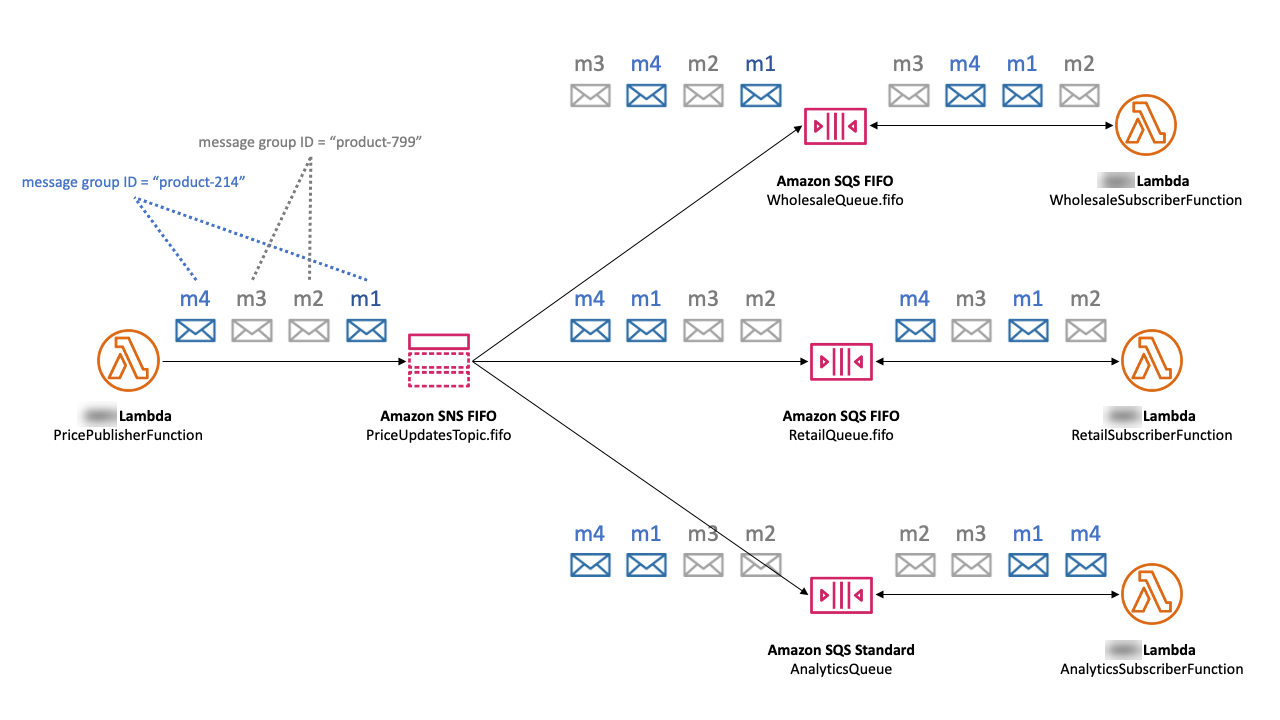Amazon SNS message grouping for FIFO topics
Messages that belong to the same group are processed one by one, in a strict order relative to the group.
When you publish messages to an Amazon SNS FIFO topic, you set the message group ID. The group ID is a mandatory token that specifies that a message belongs to a specific message group. The SNS FIFO topic passes the group ID to the subscribed Amazon SQS FIFO queues. There is no limit to the number of group IDs in SNS FIFO topics or SQS FIFO queues. Message group ID is not passed to Amazon SQS standard queues.
There's no affinity between a message group and a subscription. Therefore, messages that are published to any message group are delivered to all subscribed queues, subject to any filter policies attached to subscriptions. For more information, see Amazon SNS message delivery for FIFO topics and Amazon SNS message filtering for FIFO topics.
In the auto parts price management example use case, there's a dedicated message group for each product sold in the platform. The same Amazon SNS FIFO topic is used for processing all price updates. The sequence of price updates is preserved within the context of a single auto parts product, but not across multiple products. The following diagram shows how this works. Notice that, for the product whose message group ID is product-214, message m1 is processed before m4. This sequence is preserved throughout the workflows that use Amazon SNS FIFO to Amazon SQS FIFO. Likewise, for the product whose message group ID is product-799, message m2 is processed before m3. However, when using Amazon SQS standard queues, the message order is no longer guaranteed, and message groups do not exist. The product-214 and product-799 message groups are independent of each other, so there is no relationship between how their messages are sequenced.

Distributing data by message group IDs for improved performance
To optimize delivery throughput, Amazon SNS FIFO topics deliver messages from different message groups in parallel, while message order is strictly maintained within each message group. Each individual message group can deliver a maximum of 300 messages per second. Therefore, to achieve high throughput for a single topic, use a large number of distinct message group IDs. By utilizing a diverse set of message groups, Amazon SNS FIFO topics automatically distributes messages across a larger number of parallel partitions.
Note
Amazon SNS FIFO topics are optimized for uniform distribution of messages across message group IDs, regardless of the number of groups. Amazon recommends that you use a large number of distinct message group IDs for optimized performance.
When publishing to your Amazon SNS FIFO topic with high throughput and one or more Amazon SQS FIFO queues are subscribed, it is recommended that you enable high throughput on your queues. For more see High throughput for FIFO queues in the Amazon Simple Queue Service Developer Guide.